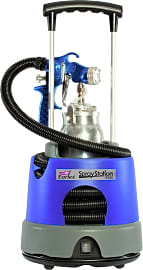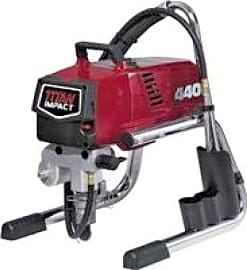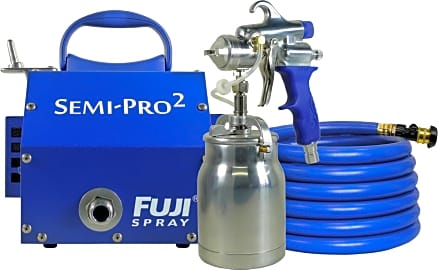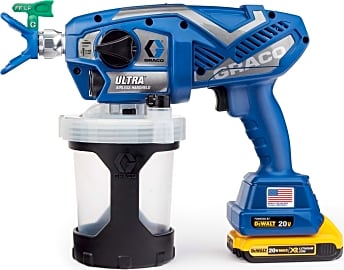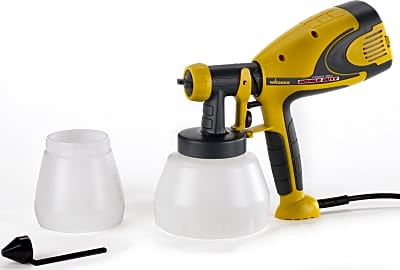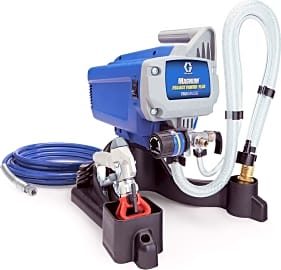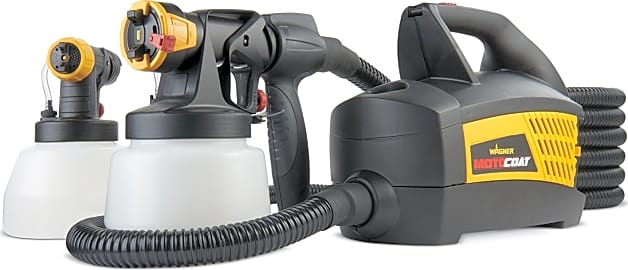The 10 Best Paint Sprayers

This wiki has been updated 44 times since it was first published in March of 2015. You should never underestimate the effect of a nice paint job. The right color can do wonders to refresh a room or the outside of a house, or give a new lease on life to some diamond in the rough you found at your local antique store. Not only are sprayers the easiest way to apply a fresh coat, but they also save a tremendous amount of time compared to rollers and brushes. When users buy our independently chosen editorial picks, we may earn commissions to help fund the Wiki.
Editor's Notes
December 08, 2020:
The Graco Magnum ProX19 Cart joins the list in this update, which is a powerful airless paint sprayer that comes with a wheeled cart and the ability to support up to 150 feet of hose. While it handles thick materials well, it’s also equipped with a reversible tip for easy unclogging. In addition to the cart option, it’s also available in a model with a sturdy integrated stand. From the same manufacturer comes the Graco Magnum 257025, which works well for beginners and is suitable for paints and stains that are unthinned. It allows you to spray directly from one- or five-gallon paint containers, and you can easily control the flow. It sports convenient onboard storage compartments with space to stow the spray gun, extra tips, and the power cord.
To make room for the two newly added models, we say goodbye today to the Graco Magnum ProX17, which offers a lower horsepower than the updated X19 and also doesn’t have the proprietary pump filter that helps reduce tip clogs from debris in the paint. Also leaving the list is the Graco Magnum X7, which is similar to the newly added X19, although not as powerful or able to support as wide of a range of tip sizes. For a reliable HVLP paint sprayer, look to the Wagner Double Duty, which comes with 1- and 1-1/5-quart sized cups and gives you the fine finish that HVLP models are known for, without a lot of waste. It boasts a durable nozzle and makes use of a two-stage, indoor and outdoor-rated air turbine. For automotive applications, consider the Wagner MotoCoat Complete, which is suitable for adding protective or decorative coatings to your car’s exterior, truck beds, trailers, and more. It comes with a nozzle for detailed finishes and another for thicker, textured ones.
For safety’s sake, when operating an airless paint sprayer, be sure to keep your hands and body away from the spray tip, and do not grasp onto a leaking hose or fitting. If you’re using flammable materials, always work in a well-ventilated area that’s free of debris.
December 04, 2019:
This round of updates, we removed the Wagner Twin Stroke 9155, due to availability issues, and replaced it with Titan Impact 440. The 440 is a skid-frame option that’s well known for high performance doing light- to medium-duty work. Given Titan’s ironclad reputation among painting professionals who depend on their tools daily, we thought a second ranking for this category was well deserved.
The HomeRight Finish Max was also eliminated this time around, after it got squeezed out by the Graco Ultra Cordless 17M363 – a handheld model that earned a lot of convenience points with its battery-powered functionality. The 17M363 runs on 20-volt DeWalt XR lithium ion batteries.
A few factors to think about while shopping in this category:
Portability: If you’re primarily looking at tackling small- and medium-sized jobs, you’ll likely enjoy the convenience of a handheld option that incorporates an integral reservoir, such as the Graco TrueCoat 360 VSP or the Wagner Double Duty. However, if you’re undertaking some larger jobs, you’ll likely want an option with a remote motor housing that can accommodate one- or five-gallon buckets of paint, such as the Graco Magnum X7 or the Titan ControlMax 1700 Pro – both wheeled models that present an additional edge in efficiency when compared to skid-frame models.
Workload: Some tools in this category might be great for infrequent use on small projects, but their motors aren’t designed to withstand the daily stress that comes with long days of contracting. Be mindful of the metrics some companies offer to help guide you here (usually recommended gallons per week/year), and in their absence, keep an eye out for motor specifications that might give you a clue.
To thin, or not to thin: Options in this category will commonly require users to “thin” paint before spraying it. While this process can be as simple as stirring half a cup of water into a gallon of latex paint, it’s still an inconvenience. Other options, like the Graco Magnum ProX17, are designed for use with undiluted paint, which is nice.
The Right Tools For The Job
When it comes to painting, there are also implements ideal for the job.
A great tool not only helps you perform a task, but it helps you get the job done better. It helps you do your work faster and with greater accuracy, too. You can certainly saw through a wooden two by four with a hacksaw, but if you use a powered miter saw, you'll cruise through the work so much faster. So too can you use a broom to clean a patio, but a leaf blower will save you time and backache. Those two tools represent the apex of design when it comes to a purpose built implement.
When it comes to painting, there are also implements ideal for the job. If you're working on an oil on canvas landscape painting, a half inch horsehair brush might be perfect for feathering color into those rolling hills. If you're working on a watercolor painting, then perhaps a small camel hair brush is right for you. If you're painting the garage door or an entire room of your house, then forget about those tiny little brushes and get yourself some serious hardware. When many people approach a large painting project, they turn to the old stand by of the paint roller. However, if you want the job done in a fraction of the time and with greater accuracy and fewer mistakes, you should be considering a good paint sprayer.
The price range in the paint sprayer category is vast; much larger, in fact, than you'll find with most other power tools. Considering that all of products perform essentially the same essential function, any cost difference comes down to one primary factor: power.
If you're staining a bench for your patio or painting a few doors for a bedroom, there's no reason to spend a small fortune on a paint sprayer. If your profession involves spraying huge volumes of paint over hundreds of square feet of surface, then the faster you spray that paint (or lacquer, stain, etc.) the more work you can take on and the more money you stand to make.
Choosing A Paint Sprayer For Home Use
Paint sprayers that are suitable for home use by the Do It Yourself type, or for use on smaller projects completed by professionals, tend to have their paint reservoir and spraying machinery all housed in a single handheld unit. Larger "professional grade" options will often have a reservoir that sits on the ground or on a wheeled frame with only the actual sprayer held in the operator's hand.
That way you can opt for broad coverage when painting a large, blank wall, for example, and use the same sprayer to stain the narrow slats of a fence another time.
Thus it is that, perhaps ironically, many of the smaller, DIY appropriate paint sprayers are de facto heavier than the professional units, inasmuch as what you'll actually be holding. Make sure your your arms, wrists, and hands are up to holding a unit weighing around ten pounds on average, which will be even heavier when loaded with paint or stain. The time a paint sprayer saves you, and the lack of repetitive motions such as those required with a brush or roller should still make the sprayer a viable option.
Unless you are certain you will use your sprayer only for one type of task, consider units that feature multiple spray patterns and spray size settings. That way you can opt for broad coverage when painting a large, blank wall, for example, and use the same sprayer to stain the narrow slats of a fence another time. Also consider units with fine nozzles for detail work; you'll be amazed at how easily you can control a paint sprayer once you have gotten comfortable using it. In skilled and experienced hands, these tools can be used for everything from edging to moldings to trim work, and using them for these specialty jobs will save a person plenty of time.
The Right Paint Sprayer For The Pros
If you're ready to spend a decent chunk of change now, you're going to reap huge rewards down the line as your professional grade paint sprayer saves you time and helps you do great work. And that's true whether you're using a sprayer to stain furniture for an entire showroom or you're painting an entire house, inside and out.
Some units can be fitted with tubes up to one hundred feet in length connecting the sprayer handle to the reservoir of paint, stain, or whatever liquid is to be applied.
The best professional paint sprayers are both efficient and powerful, and they are also pleasantly easy to use. Some units can be fitted with tubes up to one hundred feet in length connecting the sprayer handle to the reservoir of paint, stain, or whatever liquid is to be applied. That means the painter can move about his or her worksite relatively unencumbered, freely applying paint across a wide area without having to move the heavier piece of equipment.
Commercial grade paint sprayers deliver their payload with such consistent force that the paint will easily and thoroughly coat surfaces ranging from stucco to concrete to wood and more. When you pay for a unit with a motor rated at a full horsepower of strength, for example, you get a paint sprayer rated at 3000 PSI that can distribute about a half gallon of paint per minute.
This translates into painting the average sized room in about one half hour (taping and other preparation work not included, that is). It also means you can paint the average home's entire interior in about three to four hours. And that's not a bad day's work for the average professional painter. Just make sure to wear appropriate respiratory and eye covering safety gear, because these units put out a lot of material, none of it with which you want to make intimate contact.



